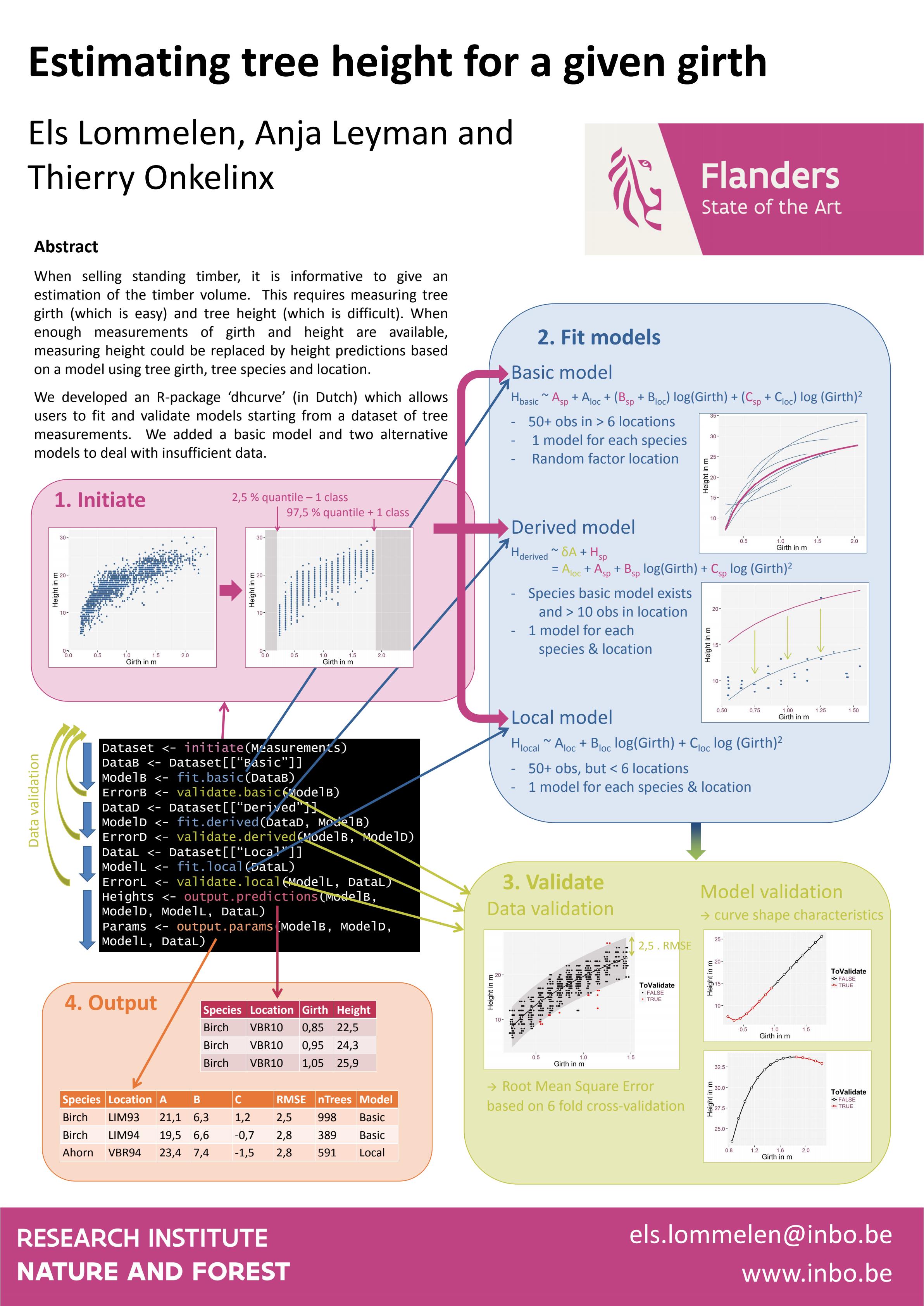Estimating tree height for a given girth
We developed an R-package ‘dhcurve’ (in Dutch) which allows users to fit and validate models starting from a dataset of tree measurements. As tree growth depends on tree species and location, separate models are fit for each tree species with location as a random factor. To obtain a reliable mixed model for a species, we recommend having at least 6 locations and each location should have 50+ observations.
We added two alternative models for species-location combinations to deal with insufficient data:
- If a tree species can not have a mixed model because fewer than 6 locations have 50+ observations, a simple model without random factor location can be fitted for each species-location combination with 50+ observations.
- If a species has a reliable mixed model and a location has fewer than 50 observations, a location-specific model can be fit, based on a vertical shift of the fixed factor of the mixed model.
After fitting the models, a validation step can be executed, which includes a validation of the data and of the model. The validation function marks data as possibly incorrect if their distance to the model is larger that 2.5 times the Root Mean Square Error (RMSE), which is calculated by 6 fold cross-validation of the dataset. Possibly incorrect models are detected after calculating curve shape characteristics. After validation by the user (and a refit of the model after data-correction), the user can obtain the results either as model parameters or as an estimated height for each girth class in a relevant interval (i.e. interval in which data were available).
Details
| Number of pages | 1 |
|---|---|
| Pages (to-from) | 1 |
| Type | Poster |
| Category | Research |
| Language | English |
Bibtex
@misc{21b6b6ae-6d83-4855-8f09-298774721fa4,
title = "Estimating tree height for a given girth",
abstract = "When selling standing timber, it is informative to give an estimation of the timber volume. This requires measuring tree girth and tree height. Measuring tree girth is easy, but measuring tree height in a forest is difficult and time-consuming. When enough measurements of girth and height are available, however, measuring height could be replaced by height estimations based on a model using tree girth.
We developed an R-package ‘dhcurve’ (in Dutch) which allows users to fit and validate models starting from a dataset of tree measurements. As tree growth depends on tree species and location, separate models are fit for each tree species with location as a random factor. To obtain a reliable mixed model for a species, we recommend having at least 6 locations and each location should have 50+ observations.
We added two alternative models for species-location combinations to deal with insufficient data:
- If a tree species can not have a mixed model because fewer than 6 locations have 50+ observations, a simple model without random factor location can be fitted for each species-location combination with 50+ observations.
- If a species has a reliable mixed model and a location has fewer than 50 observations, a location-specific model can be fit, based on a vertical shift of the fixed factor of the mixed model.
After fitting the models, a validation step can be executed, which includes a validation of the data and of the model. The validation function marks data as possibly incorrect if their distance to the model is larger that 2.5 times the Root Mean Square Error (RMSE), which is calculated by 6 fold cross-validation of the dataset. Possibly incorrect models are detected after calculating curve shape characteristics. After validation by the user (and a refit of the model after data-correction), the user can obtain the results either as model parameters or as an estimated height for each girth class in a relevant interval (i.e. interval in which data were available).",
author = "Els Lommelen and Anja Leyman and Thierry Onkelinx",
year = "2018",
month = jan,
day = "01",
doi = "",
language = "English",
publisher = "Instituut voor Natuur- en Bosonderzoek",
address = "Belgium,
type = "Other"
}

